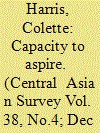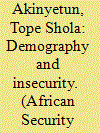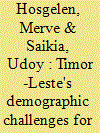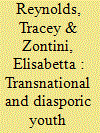|
|
|
Sort Order |
|
|
|
Items / Page
|
|
|
|
|
|
|
| Srl | Item |
| 1 |
ID:
169264


|
|
|
|
|
| Summary/Abstract |
Rather than studying young men's career- and/or economic-based aspirations, this article explores the obstacles that hinder youths of both sexes in gerontocratic southern Tajikistan and North India from developing the capacity to make their own life choices. Focusing mainly on the selection of marital partner and largely on women, I explore the narratives of those who have never even dreamed of a good life, of others who have dreamed but been unable to actualize their dreams, of a few who have started to plan the way forward, and of a tiny number who actually managed to achieve their aspirations, teasing out the influences that facilitate this. I suggest that even educated youths with some control over their public lives are constricted by their family relations and that it requires quite specific support to defy one’s family, which can create significant vulnerabilities in settings with no other safety net.
|
|
|
|
|
|
|
|
|
|
|
|
|
|
|
|
| 2 |
ID:
192063


|
|
|
|
|
| Summary/Abstract |
Insecurity is a prominent phenomenon that threatens the peace and development of Africa in general and particularly, the Lake Chad Basin [LCB]. One of the factors driving the menace is the phenomenon of youth bulge. This article argues that young people with poor economic prospects are liable to be recruited for violence. Situated within the grievance model, the article shows how youth make up the larger percentage of protesting, violent and armed groups in the region and presents evidence of how grievance against deprivation moves demography to exacerbate insecurity. The article adopts a qualitative approach and relies on secondary data sourced from briefs, government reports, peer-reviewed journal articles and internet sources. The findings show that the endless supply of children and young people in the LCB is a major factor driving insecurity. By examining the phenomenon of Almajiri, child soldiers and youth radicalisation as enablers of conflict and insecurity in the LCB, the article concludes that population explosion amid a lack of resources leads to grievance and fuels insecurity. This is significant given the paucity of literature on the incidence of demography and insurgency in the LCB; which has become a theatre of insecurity in Africa.
|
|
|
|
|
|
|
|
|
|
|
|
|
|
|
|
| 3 |
ID:
147462


|
|
|
|
|
| Summary/Abstract |
Timor-Leste's nation-building process faces significant demographic challenges because of its current and prospective population dynamics. Based on the 2010 census data this paper projects the demographic structure of Timor-Leste by 2030 and discusses the impact of the same on peace, development and environmental sustainability. This paper projects that Timor-Leste's population will increase from 1.06 million in 2010 to 1.82 million in 2030, and because of a slow decline in total fertility rates, its population characteristics will remain that of a very youthful country with an extraordinarily high dependency ratio. Timor-Leste will have extremely high proportion of excess labour, high concentration of uneducated and jobless youth in small urban areas and an ever-increasing demand on natural resources in the next two decades. In the context of poor performing domestic economy, very low formal sector employment and weak environmental governance, these challenges may well contribute to social conflict which is evident in the nation's recent past. This paper is an attempt to reflect upon the implications of Timor-Leste's population dynamics by 2030 on urbanisation, economy (labour market) and the environment which tend to have a strong relationship with social stability.
|
|
|
|
|
|
|
|
|
|
|
|
|
|
|
|
| 4 |
ID:
145862


|
|
|
|
|
| Summary/Abstract |
This special issue brings together multidisciplinary and international perspectives on the importance of diasporic and transnational networks for the formation of ethnic identity by migrant youths. Within the context of this issue migrant youths refer to young people (aged 16–35 years) who are themselves migrants or are children and grandchildren of migrants. Our attention to the transnational and diasporic identities of migrant youths is in direct response to policy debates and migration scholarship in this area, which in recent times have focused on the supposed crisis of minority ethnic youths and their perceived marginalisation and social exclusion from a wider society. The special issue broadens the parameters of this debate by exploring not how transnational migrant youths are but more interestingly, we believe, what it means for them to have grown up in a transnational social field. In the special issue rather than simply addressing identity outcomes, we want to emphasise identity processes. This is because we are more interested in understanding the ways the migrant youths are ‘doing transnationalism’ and also through this process ‘doing identity’ (including intersected racial, ethnic, gender, class and sexual identities).
|
|
|
|
|
|
|
|
|
|
|
|
|
|
|
|
|
|
|
|
|